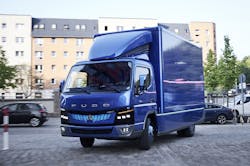Which zero-emissions tech will win trucking?
There are many competing voices championing the different approaches to addressing truck emissions, each with a different perspective or agenda. While that may be causing some confusion among fleets about future truck purchases, one thing should be clear at this point — the societal pressure and political will are in place to eliminate truck emissions. The only questions are how and when.
Putting aside the timetable, the scenario for a transition to zero-emissions, or ZE, trucks has started to become clear over the last few years. While the industry has relied on using a single power source — diesel — for decades, there will be no such silver bullet in the push for ZE. Instead, each of these technologies will find the right fit in different applications. The challenge for fleets will be to choose the right one for their particular operation.
Painting the big picture, Dr. Mihai Dorobantu of Eaton’s Vehicle Group divides ZE truck adoption into two categories.
Urban areas like southern California and other regions with ozone issues are most concerned about NOx as an air-quality and health problem. Diesel-powered trucks involved in city delivery and drayage produce a large amount of NOx, especially when they operate under low-load and low-speed conditions. Along with buses, these types of trucks typically run under 200 miles a day and return to a garage or terminal. Such characteristics address the range and recharging limits of the plug-in truck. Given the relative simplicity of a battery electric powertrain, these urban NOx-focused trucking applications will likely find plug-in ZE trucks cost-effective even if they’re not required by regulation, according to Dorobantu.
“Total cost of ownership drives [new technology] adoption,” said Mike Roeth, executive director of the North American Council on Freight Efficiency. “There’s a real chance that [battery plug-in trucks] will actually save fleets money. We’re optimistic that medium-duty box trucks and Class 8 day cabs will transition more quickly than many think.”
The second category Dorobantu sees is long haul trucking, where the emissions' focus is not air quality but rather CO2. “Long-haul transport accounts for 7% to 8% of the total energy consumed,” he said. “Today petroleum is the only source for that energy, so long-haul trucks are a significant source of carbon.”
Hydrogen fuel cells are the right ZE application for long haul, both for acceptable range with ZE and for the evolution already underway in how electric power is generated. The need to reduce overall carbon emissions is pushing electrical utilities to develop renewable sources like solar and wind power. The problem is that unlike current generating plants that can scale production to changes in demand, such sources are intermittent generators of electricity dependent on environmental conditions. Creating hydrogen with that intermittent power generation provides a buffer to store it during peaks in generation, according to Dorobantu. “Hydrogen fuel cells are a long-term solution to long haul decarbonization and to the new intermittent generation [of electricity] with renewable sources.”
While Dorobantu believes fuel cell truck technology will soon be priced competitive with diesel, the real barrier that makes it more of a long-term ZE technology is building a completely new infrastructure for hydrogen fueling.
Right now, it seems that the most practical way to distribute hydrogen for truck fuels is as a cryogenic liquid.
“Those liquid hydrogen plants are expensive and difficult to permit,” said Erik Neandross, CEO of the clean technology consulting group Gladstein, Neandross & Associates. “There’s no clear picture at this point on how all of that will happen.”
This week, we’re taking a deeper look at the future of ZE truck technologies. We’ll look at technology options week. Read Part 1 and Part 2 of this series.
About the Author
Jim Mele
Jim Mele is a former longtime editor-in-chief of FleetOwner. He joined the magazine in 1986 and served as chief editor from 1999 to 2017.
